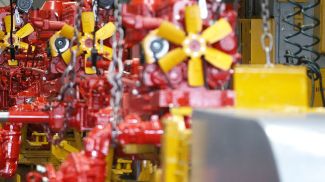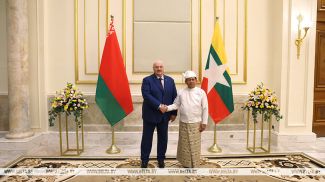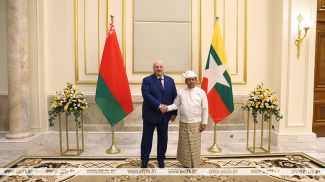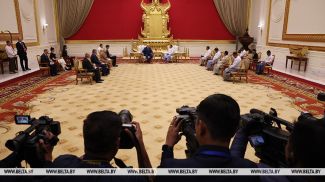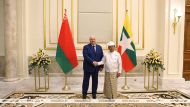An informal summit of the Commonwealth of Independent States took place in St Petersburg on 7 October. Vladimir Putin celebrated his 70th birthday on that day. Of course, the presidents did not come to visit their Russian counterpart with empty hands. For example, Aleksandr Lukashenko decided to give him an MTZ tractor. Outside the National Congress Palace in Strelna Aleksandr Lukashenko talked to reporters. “What did you bring as a gift if you don't mind asking?” the reporters wondered. “A tractor,” Aleksandr Lukashenko responded. When asked to clarify what kind of a tractor, the president noted: “The one that I use, which is a BELARUS tractor. The best one. A hand-built one.” Why a tractor? It's simple: MTZ is a national brand. Let's recall who and why authorized the construction of a tractor factory in Minsk and why Aleksandr Lukashenko's visit to the enterprise literally saved it. All the details in this episode of BelTA's project After the Fact: Lukashenko's Decisions.
When did the construction of Minsk Tractor Works begin?
The year 1946 is the official starting point in the history of Minsk Tractor Works. But perhaps we will go back to the pre-war period and start with 1939. In September the USSR Defense Committee authorized the construction of about ten new aircraft factories in the country. The construction of one of them began in Minsk. Construction was overseen by Stalin himself. The grandeur of the construction is evidenced by the number of workers - more than 10,500 people worked at the site.
The plant was being built fast, but the war intervened in the ambitious plans. During the Nazi occupation of Minsk the Germans used the few finished shops to repair aircraft. After the liberation of the Belarusian capital, the Soviet authorities decided to restore the plant as an aviation plant. Yak-9 planes were assembled here. There were plans to assemble Tu-2 bombers as well.
Igor Kuznetsov, Head of the MTZ's Museum and Industry Center, said: “But the decision to build a tractor factory here was made in 1945. Stalin together with the then leader of Soviet Belarus Ponomarenko made the decision. The Soviet government passed a resolution on the construction of Minsk Tractor Works on 29 May 1946.”
Why did they decide that? The reason lay on the surface. It was necessary to heal the wounds inflicted by the war on agriculture. And return people to a decent life. The presence of a major industrial enterprise in Minsk could improve the economy of the city and the country. The construction of Minsk Tractor Works was declared an all-Union shock-work construction site. As they say, the enterprise was built by the entire Soviet nation.
What tractors were assembled at MTZ initially?
In the first few years MTZ assembled tracked tractors designed in Lipetsk and Leningrad.
The first wheeled tractor, which was fully designed and assembled at Minsk Tractor Works, was called Belarus. The experimental model MTZ-1 was produced in 1949. The batch production of a very similar model, MTZ-2, began in 1953. This event became a turning point in the history of the enterprise and determined its further specialization. By the way, everyone can see the first batch-produced MTZ-2 tractor. It was put on a pedestal in a garden square outside the factory.
Igor Kuznetsov remarked: “This tractor worked in Kopyl District for 18 years. But in 1971 MTZ returned the tractor to the place it was born and restored it. It is our first Belarusian tractor.”
In the same year, 1953, the first trains carrying MTZ-1 and MTZ-2 tractors left the factory. The steel “helpers” were sent to Russian, Ukrainian, Georgian, Latvian, and Estonian state and collective farms.
Over the years Minsk Tractor Works evolved into one of the largest industrial sites in the Soviet Union. The enterprise worked hard to improve technologies and develop more and more new models. The factory takes pride in every model. But only thanks to one of the models – Belarus 80/82 – the enterprise and the country are known on five continents. Batch production of the model began in 1974. Upgraded versions of this tractor are still being produced because customers keep buying them. The tractor is truly a legend.
Where were Belarusian tractors sold?
During the Soviet period tractors were shipped to socialist countries. Up to 50,000 tractors to Russia every year. In addition, 20% of the tractors were exported to France and England. In some years about 2,000 tractors were shipped to the USA. Even special models were produced for the West African Republic of Mali - cotton tractors designed for tropical conditions.
Igor Kuznetsov went on saying: “In 1973 our tractor MTZ 80 was submitted to lab tests at University of Lincoln, State of Nebraska, USA. The testbed trials ran continuously for 21 hours. The tractor handled the trials with confidence. Right after the trials the tractor model was inscribed into the honor book. Export shipments to the United States of America and Canada went up.”
As he visited the agricultural enterprise Zhuravlinoye in August 2022, Aleksandr Lukashenko recalled how he had met an American farmer owning an old Belarusian tractor.
The president said: “I was in America a long time ago. I come to this farm and see a John Deere. I go into another garage and see a rotten MTZ 50. I say: ‘Listen, what is this?' I was delighted. An MTZ 50. We didn't have them already. We had MTZ 90, 120, 150 available already. This American farmer came up, hugged this tractor and started kissing it. I asked him why. He said: ‘My children will not be able to pay up for that terrible John Deere. But this little tractor is still operational.' I told him: ‘You are such a patriot, there are no such people in Belarus.'”
What happened to MTZ in the 1990s?
The factory faced difficult times after the collapse of the Soviet Union. The market, which provided jobs to many thousands of people, fell into pieces. Instead of developing new models, design bureaus had to draw stools and metal cabinets.
Yuri Sosonka, mechanical assembly fitter, who has been working at MTZ since 1986, recalled: “We had no orders, no sales. Naturally we didn't work the full week or even the full day.”
According to Nikolai Tsimanovich, fixer of automatic lines and equipment, who has been working at MTZ since 1992, salaries were quite small back then. All the enterprises were in the same situation in the early 1990s. “Well, we managed somehow. We didn't make anything. We earned very little. I guess about USD30 per month,” the worker said.
Rumor has it that the management of the enterprise wanted to privatize the plant on the quiet. Following the example of many neighbors. But the presence of defense manufacturing here prevented them from carrying out their plans - the enterprise assembled tracked chassis for anti-aircraft missile systems among other things. In order to take over the factory as soon as possible, the management destroyed the unique equipment that allowed making high-precision hydraulics. They took out precious metals out of the equipment and paved over the rest with concrete.
Yuri Sosonka said: “Some said that it might be a good idea to sell off the factory to someone. But mainly everyone was in favor of preserving the factory and keeping it in the hands of the state. Naturally a private owner would not keep so many workers. A private owner would make something but things would have been totally different. But this way the worker collective was preserved and the factory is already expanding in many ways. Demand for the vehicles and machines we make even exceeds our supply.”
In 1994 the state adopted a policy in favor of preserving enterprises and worker collectives. In 1995 the Belarus president visited Minsk Tractor Works and, as his press service reported, made a fundamental decision to preserve tractor production in the country. And soon the state of affairs at MTZ started improving. Yuri Sosonka remembers that day.
The worker said: “The president told us the factory will keep working. By any means. We trusted his word. And we stayed. In 1995 I was not inclined to seek some other employment. We hoped things would improve. And they did. Certainly, my hope was justified. Things started improving little by little with time.”
In the same year the three-millionth tractor rolled off the factory's main assembly line. The enterprise bought the millionth tractor and the two-millionth tractor from the owners and restored them later on. Now all the rarities are once again operational!
What did Lukashenko say about MTZ's privatization in the past?
Some doubted Aleksandr Lukashenko's policy regarding privatization. There were critics and very zealous critics. But over the years of his presidency time demonstrated that it is necessary to firmly defend national interests in this matter. It is not surprising that potential buyers of Belarusian enterprises had to comply with a bunch of conditions. To preserve worker collectives intact was the main one. No one has agreed to buy enterprises in Belarus under such conditions. It probably says a lot.
As he visited MTZ in May 2020, Aleksandr Lukashenko said that indiscriminate privatization is not his policy but he does not mind selling state property.
He said: “I don't mind selling state property. But you have to tell me first how much you will pay. And I will think whether we should sell the enterprise and whether it is worth selling it. The work of those who are no longer with us has been invested in this place. How can we take it and sell it? In the name of what, why? Let's try to work ourselves so that people would need the goods that you produce. I have a single requirement for you: if you do poor work, you will be poor. Because competition for your kinds of products is colossal, you know it.”
Aleksandr Lukashenko has always maintained this stance. When he rejected the government's proposals on indiscriminate privatization in 2016, he said: “Today we are ‘selling' something that does not entirely belong to us. There is the work of generations of our people, our grandfathers and fathers. Therefore, we must approach these matters very carefully. I cannot give even a single brick away to anyone because colossal labor has been invested in it. We should go ahead with privatization but under certain conditions: human rights, first of all, the right to work, modernization of the enterprise, an increase in tax payments to the state budget, a modern enterprise that produces goods on foreign markets - no questions asked. We will authorize such privatization. The country does not need a different kind”.
What makes MTZ proud today?
Today the Belarus Tractors brand represents more than 100 models of tractors in more than 200 modifications. For all climatic and operating conditions. Belarusian tractors work the land on five continents.
Over the years of operation of Minsk Tractor Works MTZ products have been exported to more than 120 countries. Export shipments account for over 90% of the total output. In 2018-2021 alone MTZ sales exceeded $2.2 billion. Now there are about 60 countries on the company's export map. Almost half of the shipments go to Russia.
At the same time Minsk Tractor Works is interested not only in direct sales, but also in manufacturing cooperation. More than 10 MTZ assembly plants have been opened in Russia, Azerbaijan, Kazakhstan, Tajikistan, Ukraine, Romania, Serbia, and Moldova.
Tractor number 4 million rolled off this assembly line in February 2022. It went to work in the agricultural enterprise Rodina in Belynichi District, Mogilev Oblast.
What tractor did Lukashenko gift to Putin?
But which one of the hundred models went to Vladimir Putin? It's not a secret. The Russian president received a Belarus 1523.3 tractor as a gift. The flagship model of Minsk Tractor Works boasts advanced technologies. The gift stems from a basic model tweaked according to a special specification. It was still being assembled in the company's pilot manufacturing division in October.
Under the hood the MTZ tractor has a 155hp engine made by Minsk Motor Plant. The body's design was tweaked. The tractor uses lighting equipment made by the Belarusian holding company Automotive Components with spot optics. Special cushioning of the cab reduces the transmission of vibrations to the driver's workstation. The cab itself has a comfortable seat with air suspension, a climate control system, electrically adjustable mirrors, and a radio. In addition, it has an instrument panel that improves interior design and information content. In general, it is the best option for toiling hard for the good of the country. Thus, Vladimir Putin got one more reliable Belarusian friend. And these are not assurances of marketing consultants. But the opinions of ordinary tractor drivers with half a century of experience.
Lidia Sulim, curator of the amelioration museum of the Lyuban-based land amelioration enterprise, is a famous tractor driver. She said: “Our tractors – Soviet tractors as they say now – are very resilient. They were manufactured with quality in mind both in the 1950s, in the 1980s, and at present. The president certainly gifted a very good tractor. Well done!”
Why would Putin need a tractor?
One wonders how Vladimir Putin himself will use the tractor. Aleksandr Lukashenko came up with an idea while talking to reporters in St Petersburg: “I will offer him one attachment - a mounted tool - a seeder. We will sow cereals. Maybe something else. It is a universal attachment. We will grow and sell it to Duda, Morawiecki, Europe so that they would not starve. So that they would not steal bread from Ukraine, but bring it to poor countries.”
To whom else did Lukashenko gift a tractor?
The Russian leader is not the only president to receive a Belarusian tractor as a gift. In 2018 Aleksandr Lukashenko paid an official visit to Georgia. In Tbilisi the Belarus president held talks with his Georgian counterpart Giorgi Margvelashvili. And after the reception Aleksandr Lukashenko gifted a compact tractor Belarus 152 to the president of Georgia.
The model was chosen for a reason. Giorgi Margvelashvili - at least back then - cultivated an orchard and a vegetable garden on his personal plot. He had even previously published photos of the harvest grown using Belarusian potato seeds. In general, such a tractor would be very useful for an amateur farmer.
The former president of Moldova Igor Dodon has also been seen driving a Belarusian tractor. He was accompanied by Aleksandr Lukashenko. In April 2018 the heads of state visited the Porumbeni Horticulture Institute in Moldova. There they took part in the Field Day ceremony dedicated to the beginning of the sowing campaign. A week earlier Belarus had gifted tractors and utility vehicles of Belarusian make to Moldova. The presidents may have used those to seed the crops.
And even earlier, in July 2015 Aleksandr Lukashenko taught the famous French actor Gerard Depardieu how to drive a tractor. The head of state gave Gerard Depardieu a brief tour of the presidential residence Ozerny in Ostroshitsky Gorodok. He introduced him to some samples of Belarusian agricultural machinery. He taught him manual mowing and then seated the actor in the tractor cab.
The actor Steven Seagal, who came to visit the president a year later, was less fortunate in this regard. He did not see a scythe or a tractor. But he tried many dishes of Belarusian cuisine.
MTZ tractors can be surprising in many aspects. They win tractor biathlons, participate in dance battles and serve as a chariot for Grandfather Frost. And Belarusians themselves know how to surprise people. At least by preserving their giant industrial enterprises. By advancing the enterprises to new heights on their own and converting them into genuine national legacy. Trust me, Belarusians will still surprise you! They will surprise you thanks to Lukashenko's decisions.




